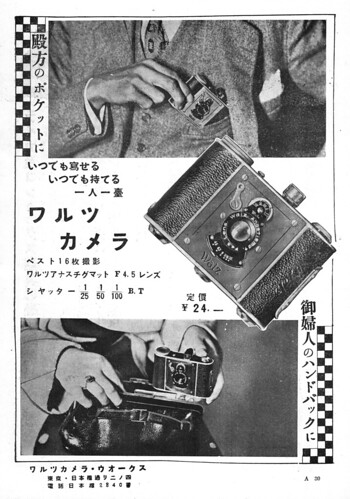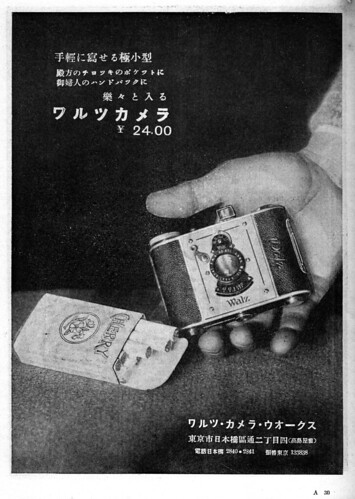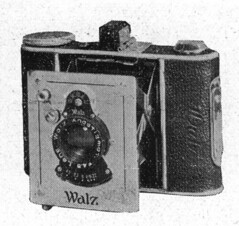Walz (3×4)
The Walz (ワルツ)[1] is a Japanese strut folder taking 3×4cm pictures on 127 film, sold in 1936 and 1937.[2]
For the postwar company of the same name, see Walz.
Contents
Description
The Walz was loosely inspired by the Foth Derby. It has a metal body with round edges. The front standard is metal coloured and is mounted on a pair of scissor struts placed on each side. The advance knob is at the top right, as seen by the photographer, and there is a smaller film flange at the top left. The tubular optical finder is attached to the top plate by a hinge, to gain a few millimetres in height when closed (same system as on the Derby). There is a small button placed to the right of the finder; it looks like a body release but is simply used to open the front standard. The back is hinged to the right. Film advance is controlled via one or several red windows, protected by cover(s).[3] The exposure chamber has guide rolls on both sides, to enhance film flatness.[3] The name Walz is inscribed at the bottom of the front plate and is embossed in the leather covering at the front of the camera. The dimensions are 9×7×3cm.[3]
The lens is a fixed-focus Walz Anastigmat f/4.5, whose focal length is unknown (it is probably 50mm). It is engraved Lens Walz Anastigmat F4.5 N°xxx. (Early advertising pictures do not show a serial number, perhaps because they were retouched.) The shutter is placed behind the front plate. It gives 25, 50, 100, B, T speeds selected by a dial placed above the lens. This dial is engraved Walz. The aperture is controlled by an index at the bottom, moving on a crescent-shaped scale. The everset shutter is tripped by a lever attached to the front plate.
Advertisements, manufacturer

|
| Announcement in Asahi Camera November 1936. (Image rights) |
The Walz was first advertised in October 1936,[4] and was featured as a new product in the November 1936 issue of Asahi Camera, reproduced above.[3] In the document, the camera is called "Walz A Pocket Camera" (ワルツAポケットカメラ), and the price is given as ¥24.

|

|

|
| October 1936 | December 1936 to February 1937 (that dated November 1936 is similar) |
March 1937 (that dated April 1937 is similar) |
| Advertisements for the Walz in Asahi Camera. (Image rights) | ||
The advertisements placed in Asahi Camera from October 1936 to April 1937 are reproduced above.[5] In most of these, the camera was touted as suited "for the gentlemen's pockets and for the ladies' handbags" ("殿方のポケットに・御婦人のハンドバッグに"), and with appropriate pictures. All the documents give the same price of ¥24, and were ostensibly placed by "Walz Camera Works" (ワルツ・カメラ・ウオークス).
Later advertisements dated June 1937 say that the camera was "made by Walz Works" (ワルツウオークス製) and mention the company Nihon Shōkai, certainly as the distributor.[6] The camera is listed at an unchanged price, an ever-ready case is mentioned for ¥3.50, and another accessory for ¥3.00 (perhaps a hood with filter holder).[7]
It is doubtful that Walz Works or Walz Camera Works was the name of an actual company. It seems that this kind of names was only used for advertising purposes and hides the true name of the manufacturing company (see Camera Works). In the case of the Walz, various sources say that the actual maker was Okada Kōgaku.[8] The brand name Walz was certainly owned by the distributor Nihon Shōkai, which was surely a predecessor to the postwar Walz camera manufacturer.
Notes
- ↑ This camera is called "Walz Baby" in Sugiyama, item 1262, and McKeown, p.745, but it is simply called "Walz" in the two advertisements observed.
- ↑ Dates: advertisements listed in Kokusan kamera no rekishi, p.344.
- ↑ 3.0 3.1 3.2 3.3 Column in Asahi Camera November 1936, p.861. The document also says that the camera weighs 50g (五〇瓦), certainly by mistake.
- ↑ Kokusan kamera no rekishi, p.344.
- ↑ Advertisements in Asahi Camera October 1936, p.A24, November 1936, p.A20, December 1936, p.A30, January 1937, p.A30, February 1937, p.A29, March 1937, p.A30, and April 1937, p.A23. That dated December 1936 is also reproduced in Kokusan kamera no rekishi, p.107.
- ↑ Advertisement in Asahi Graph, 16 June 1937, formerly reproduced at the Gochamaze website (archived), and advertisement in Ars Camera June 1937, observed in an online auction.
- ↑ The case is mentioned in both advertisements, and the other accessory is mentioned in the advertisement in Ars Camera.
- ↑ Kokusan kamera no rekishi, p.344; Sugiyama, item 1262; McKeown, p.745.
Bibliography
Original documents
- Asahi Camera November 1936. "Atarashii kikai to zairyō" (新しい機械と材料, New equipment and machinery). P.861.
- Asahi Camera. Advertisements by "Walz Camera Works":
- October 1936, p.A24;
- November 1936, p.A20;
- December 1936, p.A30;
- January 1937, p.A30;
- February 1937, p.A29;
- March 1937, p.A30;
- April 1937, p.A23.
Recent sources
- Asahi Camera (アサヒカメラ) editorial staff. Shōwa 10–40nen kōkoku ni miru kokusan kamera no rekishi (昭和10–40年広告にみる国産カメラの歴史, Japanese camera history as seen in advertisements, 1935–1965). Tokyo: Asahi Shinbunsha, 1994. ISBN 4-02-330312-7. Item 346.
- McKeown, James M. and Joan C. McKeown's Price Guide to Antique and Classic Cameras, 12th Edition, 2005-2006. USA, Centennial Photo Service, 2004. ISBN 0-931838-40-1 (hardcover). ISBN 0-931838-41-X (softcover). P.745.
- Sugiyama, Kōichi (杉山浩一); Naoi, Hiroaki (直井浩明); Bullock, John R. The Collector's Guide to Japanese Cameras. 国産カメラ図鑑 (Kokusan kamera zukan). Tokyo: Asahi Sonorama, 1985. ISBN 4-257-03187-5. Item 1262.
